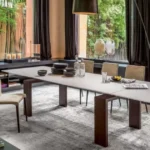A studio apartment is a small living space that combines several rooms into one. It typically includes a bedroom, living room, and kitchenette in a single open area. Studio apartments are designed for individuals or couples who want a compact living space with all the essentials in one place.
They are perfect for those who prefer simplicity and efficiency, offering a cozy and manageable environment. Despite their limited square footage, studio apartments can be creatively designed to maximize functionality and comfort.
What is a 1-bedroom apartment?
A 1-bedroom apartment is a living space with a separate bedroom, living room, kitchen and bathroom. It’s larger than a studio apartment, providing more privacy and distinct areas for different activities. These apartments are ideal for individuals or couples who want a bit more space and separation between living and sleeping areas.
They offer the convenience of a full kitchen and often have additional storage space compared to studios. One-bedroom apartments are versatile and can accommodate various living styles.
Studio vs. 1-bedroom: Factors to consider when selecting your apartment
This table compares the key factors between studio apartments and 1-bedroom apartments, highlighting the differences in space, privacy, cost, customization, lifestyle suitability, convenience, long-term living, value for money, flexibility, storage, maintenance and investment value.
| Aspect | Studio Apartment | 1-Bedroom Apartment |
| Space | Combines bedroom, living room, and kitchenette in one open area, ideal for singles or couples who prefer compact living. | Provides separate bedroom, living room, kitchen, and bathroom, offering more space and privacy, suitable for individuals or couples wanting distinct areas. |
| Privacy | Limited privacy due to the open layout, with no separate bedroom. | Offers more privacy with a dedicated bedroom, making it suitable for those who value personal space. |
| Cost | Generally more affordable due to smaller size and fewer rooms. | Typically higher rent due to increased space and additional rooms, but may offer better value in terms of privacy and comfort. |
| Customization | Limited space may require creative storage and furniture solutions. | More room for customization and personalization, allowing for a variety of furniture arrangements and storage options. |
| Lifestyle | Suited for minimalists or those who prefer simplicity and easy maintenance. | Accommodates various lifestyles, from individuals to couples or small families, providing flexibility and options for diverse living needs. |
| Convenience | Offers convenience with all essentials in one area, making it easy to access everything within reach. | Provides a full kitchen and separate living areas, offering convenience in terms of cooking, entertaining, and living spaces. |
| Long-term Living | Ideal for short-term living or those who don’t require much space. | Suitable for long-term living, especially for individuals or couples planning to stay in one place for an extended period. |
| Value for Money | Offers affordability and cost-effectiveness, especially for budget-conscious individuals. | Provides better value in terms of space and privacy, making it worth the investment for those prioritizing comfort and convenience. |
| Flexibility | Limited in terms of accommodating guests or expanding living space for future needs. | Provides flexibility with separate rooms, making it easier to adapt to changing lifestyles or housing requirements. |
| Storage | Limited storage space may require creative organization methods. | Offers more storage options with additional rooms, closets, and built-in storage solutions. |
| Maintenance | Requires less maintenance and cleaning due to smaller size and simpler layout. | May require more maintenance but allows for easier organization and maintenance of separate living areas. |
| Investment Value | Generally lower investment value due to limited space and potential resale limitations. | Higher investment value due to increased space and potential for resale to a wider range of buyers. |
Read this blog: Luke Kuechly House: An In-Depth Look At $2.39 Million Property In Charlotte, North Carolina
Types of Studio Apartments
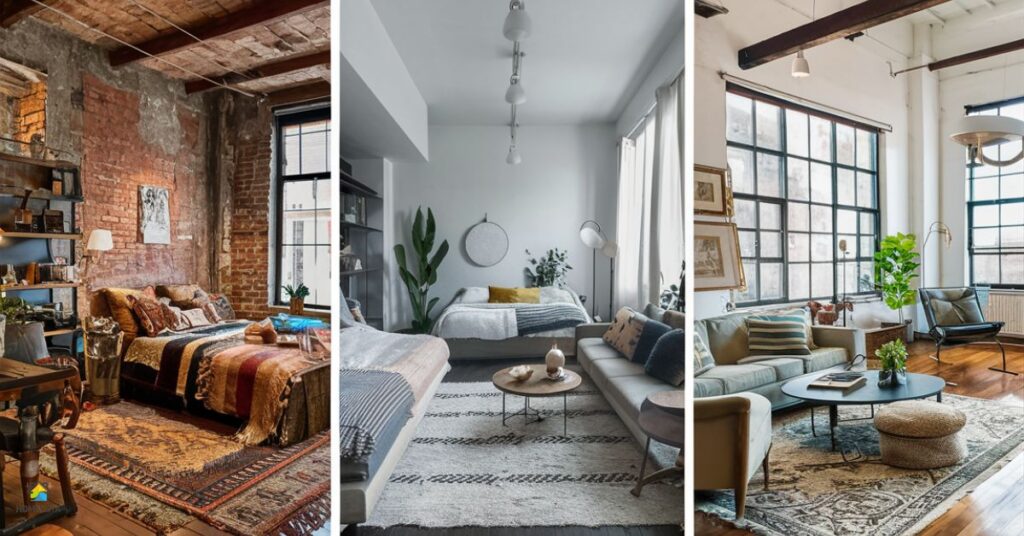
Here are different types of studio apartments explained briefly:
Traditional Studio: Includes a single open space for living, sleeping, and cooking, with a separate bathroom. Ideal for individuals or couples seeking a compact living space.
Convertible Studio: Features a layout that allows for a separate sleeping area, often achieved with partitions or sliding doors. Offers enhanced privacy and functionality.
Alcove Studio: Similar to a traditional studio but with a designated alcove space for sleeping, providing a semi-separated bedroom area within the main living space.
L-Shaped Studio: Utilizes an L-shaped layout to create distinct zones for living, sleeping, and dining within a single open area, maximizing space efficiency.
Junior 1-Bedroom Studio: Combines aspects of both studio and 1-bedroom apartments, featuring a separate sleeping area without a full bedroom, suitable for singles or couples who desire a bit more privacy.
Common Features of Studio Apartment
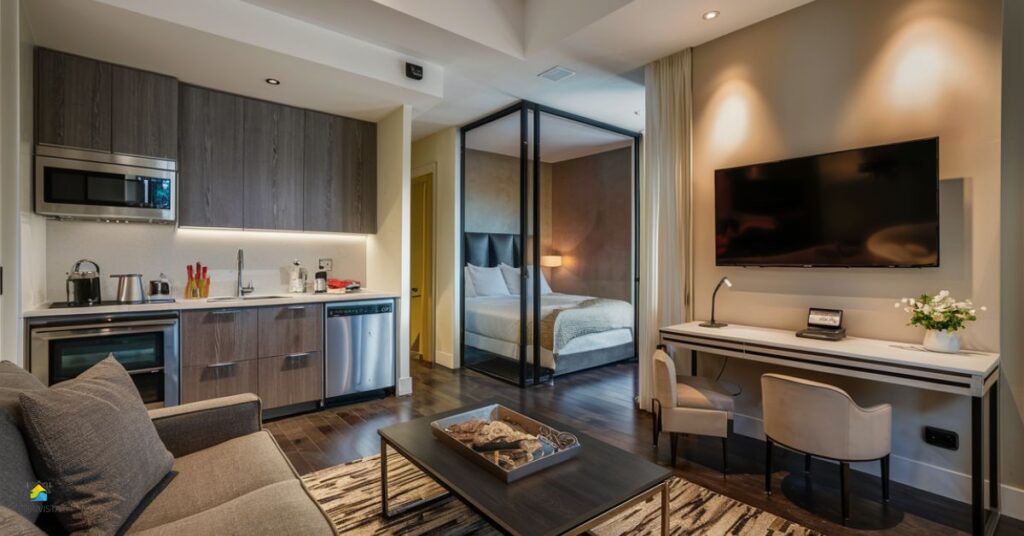
Here are some common features you’ll find in studio apartments:
- Open Layout: Typically, a single open space combines the living, sleeping and kitchen areas.
- Compact Kitchenette: Includes essential appliances like a stove, refrigerator and sink, often in a smaller size.
- Bathroom: A private bathroom with a shower, toilet and sink is standard.
- Closet Space: Limited but functional closet space for clothes and storage.
- Efficient Design: Utilizes space-saving techniques like built-in shelves, multifunctional furniture and compact layouts.
- Natural Light: Large windows or glass doors to maximize natural light and create an airy feel.
- Amenities: Some studios may offer shared amenities like laundry facilities, gyms, or communal spaces for residents.
What are the disadvantages of living in a studio?
Here are the advantages of living in a studio apartment:
- Affordability: Lower rent and utility costs compared to larger apartments.
- Easy Maintenance: Less space means less cleaning and upkeep.
- Cozy Atmosphere: Small size creates a cozy and intimate living environment.
- Convenience: Everything is within reach due to the compact layout.
- Efficient Use of Space: Clever designs maximize functionality in a small area.
- Flexibility: Easier to personalize and rearrange furniture to suit your needs.
- Minimalist Lifestyle: Encourages a simpler and more minimalist lifestyle.
- Location: Often located in urban areas with easy access to amenities and transportation.
- Privacy: Limited space means fewer areas for clutter or unwanted guests.
- Sense of Independence: Perfect for individuals or couples seeking independence and autonomy.
What are the Advantages of living in a studio?
Here are the advantages of living in a studio apartment presented in bullet points:
- Lower rent and utility costs compared to larger apartments.
- Less space means less cleaning and upkeep.
- Creates a cozy and intimate living environment.
- Everything is within reach due to the compact layout.
- Clever designs maximize functionality in a small area.
- Easier to personalize and rearrange furniture.
- Encourages a simpler and more minimalist lifestyle.
- Often located in urban areas with easy access to amenities.
- Limited space means fewer areas for clutter.
- Perfect for individuals or couples seeking independence.
What’s Included in a Studio Apartment?
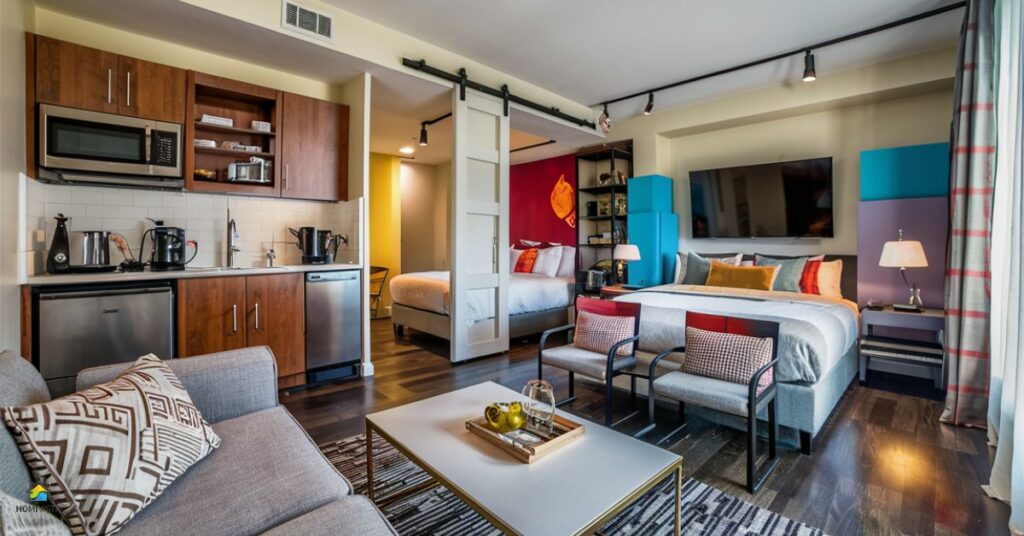
Here’s a breakdown included in a studio apartment:
- Open Layout: Single open space for living, sleeping, and dining.
- Kitchenette: Compact kitchen with essential appliances like a stove and refrigerator.
- Bathroom: Private bathroom with a shower, toilet, and sink.
- Closet Space: Limited but functional closet space for storage.
- Living Area: Space for seating, entertainment, and relaxation.
- Bedding: Bed or sofa bed for sleeping.
- Utilities: Access to electricity, water, and heating/cooling systems.
- Window(s): Natural light source and ventilation.
- Internet/Cable: Often available for connectivity and entertainment.
- Some Furnishings: Basic furnishings like tables, chairs, and storage units may be included.
Studio Apartment Kitchen
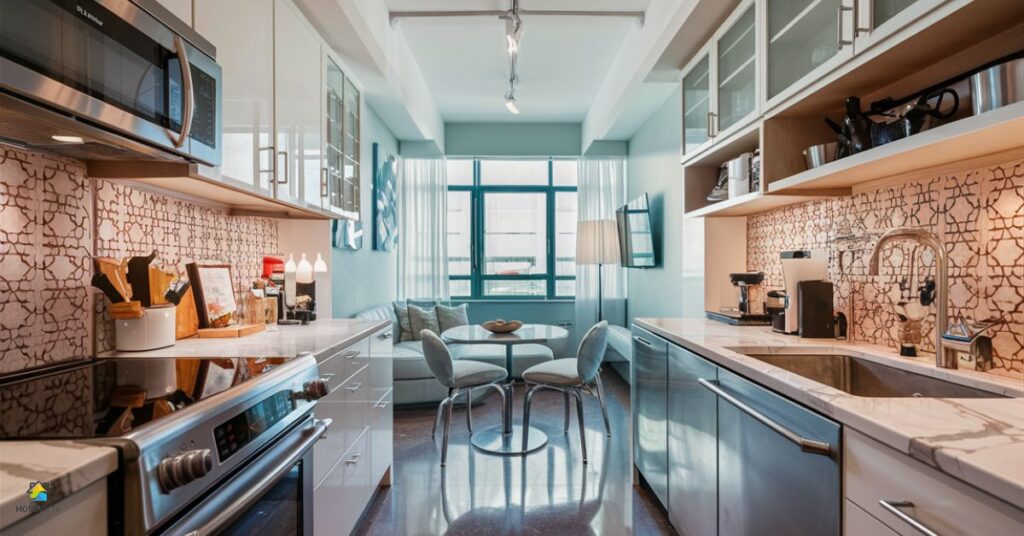
Virtual kitchen in a studio apartment would likely be compact yet functional. Here’s what you might find:
- Compact Appliances: A small stove or cooktop, a compact refrigerator, and a microwave to save space.
- Minimalist Design: Simple cabinets and shelves for storage, with a small countertop for food prep.
- Essentials Only: Basic cooking utensils, pots, and pans for everyday cooking needs.
- Efficient Layout: Everything within reach to make cooking and cleaning easier in a limited space.
- Multi-Functional: Appliances like a toaster oven or a coffee maker that serve multiple purposes.
- Space-Saving Solutions: Foldable tables or wall-mounted shelves to maximize space when not in use.
- Organizational Tools: Hooks, racks, or magnetic strips for hanging utensils and keeping things organized.
- Lighting: Adequate lighting, perhaps with under-cabinet lights, to illuminate the workspace.
- Ventilation: A small exhaust fan or window for ventilation while cooking.
- User-Friendly: Designed for convenience and practicality, making cooking enjoyable even in a small kitchen.
Also read: Gabriel Swaggart’s House Unlock The Secrets
How to Organize a Studio Apartment
Organizing a studio apartment can be a breeze with these tips:
- Declutter First: Get rid of items you don’t need or use regularly to create more space.
- Multi-Functional Furniture: Opt for furniture pieces that serve multiple purposes, like a sofa bed or a coffee table with storage.
- Divide Zones: Use area rugs, curtains, or furniture placement to visually separate different areas such as the living, sleeping, and dining areas.
- Vertical Storage: Utilize wall-mounted shelves, hooks, and racks to maximize vertical space and keep things off the floor.
- Storage Solutions: Invest in storage bins, baskets, and organizers to keep belongings tidy and easily accessible.
- Dual-Purpose Rooms: Consider combining rooms like the bedroom and home office to save space.
- Utilize Doors: Install over-the-door organizers or hooks for additional storage.
- Downsize Electronics: Opt for smaller electronics and gadgets to reduce clutter.
- Keep It Clean: Regularly clean and tidy up to maintain a sense of spaciousness.
- Personalize Thoughtfully: Add decorative touches and personal items but avoid overcrowding surfaces.
Frequently asked questions
How do I maximize storage in a small studio apartment?
You can maximize storage by using vertical space with wall-mounted shelves, utilizing multi-functional furniture with built-in storage and using storage bins or baskets to keep items organized.
What are some space-saving furniture ideas for a studio apartment?
Some space-saving furniture ideas include sofa beds, foldable tables and chairs, wall-mounted desks and ottomans with hidden storage.
How can I create privacy in a studio apartment?
You can create privacy by using room dividers, curtains, or folding screens to separate different areas such as the bedroom and living room.
What should I consider when decorating a small studio apartment?
Consider using light colors to make the space appear larger, incorporating mirrors to create the illusion of space, and using multi-functional furniture to maximize functionality.
How do I make a small kitchen in a studio apartment more efficient?
You can make a small kitchen more efficient by using wall-mounted storage, organizing cabinets and drawers with dividers and keeping only essential kitchen tools and appliances.
What are some tips for keeping a studio apartment clean and organized?
Some tips for keeping a studio apartment clean and organized include decluttering regularly, establishing designated storage areas and following a daily cleaning routine.
How can I make a studio apartment feel more spacious?
You can make a studio apartment feel more spacious by using furniture with exposed legs to create an airy feel, minimizing visual clutter and incorporating mirrors to reflect light.
What is some budget-friendly ways to decorate a studio apartment?
Some budget-friendly ways to decorate a studio apartment include shopping at thrift stores or flea markets for unique pieces, DIY projects and using removable wallpaper or decals for a pop of color.
Conclusion
Organizing and maximizing space in a studio apartment is all about creativity and practicality. By decluttering regularly, utilizing multi-functional furniture and implementing smart storage solutions, you can create a comfortable and organized living environment. Incorporating visual dividers and strategic furniture placement can help define separate zones within the studio, providing a sense of privacy and functionality.
Keeping a studio apartment clean and tidy is essential for maintaining a sense of spaciousness and comfort. Establishing a daily cleaning routine, utilizing storage bins and organizers and investing in space-saving furniture can all contribute to a well-organized and inviting living space. With thoughtful planning and attention to detail, even the smallest studio apartment can feel like a functional and stylish home.

Meet Harry, our seasoned home decor specialist with three years of hands-on experience. His passion lies in crafting inviting spaces that reflect your style. From cozy corners to vibrant living rooms. Harry’s keen eye for design ensures every detail enhances the overall aesthetic. Trust him to turn your home into a personalized haven, blending functionality with flair.



